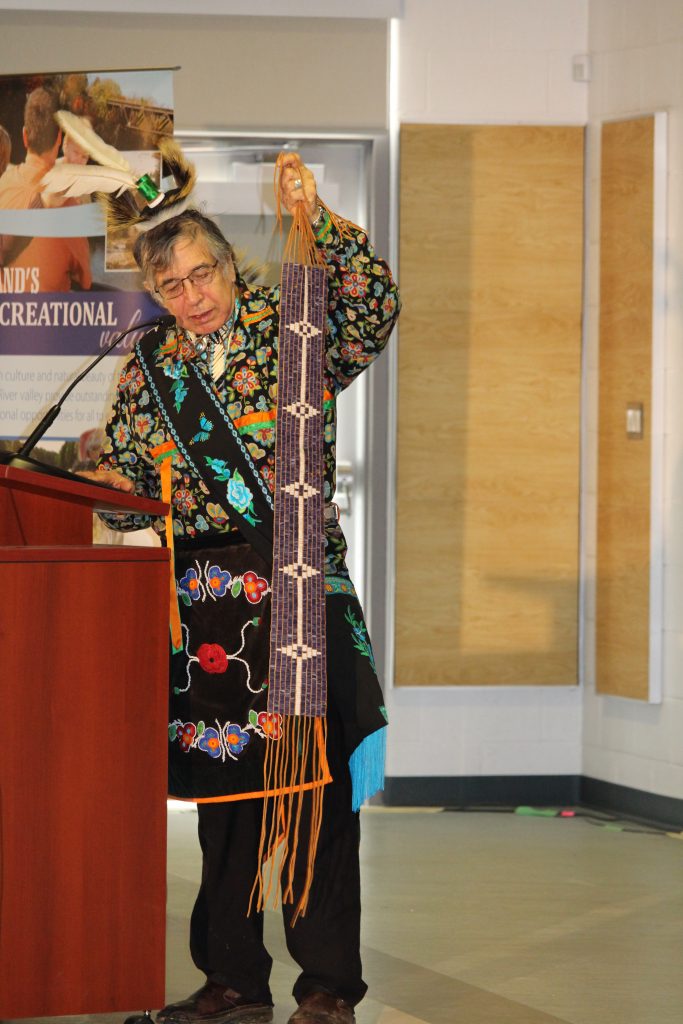 |
 |
Photographs (left to right): Mohave Desert, Nevada/California
Wampum Belt Archive
Anishinabek Treaty Belt
Graphic: Hamell 2018

http://mncfn.ca/elder-garry-sault-talks-wampums/
Re-construction using polymer beads (Alan Corbiere, 2019)
See Corbiere's article on the making of the belt.
Original Size: |
|
Reproduction: |
|
Beads: |
|
Materials: |
Description:
Belt associated with the Treaty of Niagara (1764)
Wampum belts tell history through symbolism and interpretation. There are many wampum belts made by various Indigenous groups in Canada and the United States. Wampum shells were named after the Wampunum (sic) people. Wampum belts can be described as visual interpretations of covenants and agreements made of beads fashioned from the shells of wampum.
During the annual MNCFN Historical Gathering in February, Elder Garry Sault explained the meaning and significance of some of the more well-known wampum belts in existence. Sault spent his childhood learning about culture and history from his grandparents.
He explained in depth one belt of particular importance: the “Chief Yellowhead Belt.” Corbiere (2019) stated: " “I don’t like calling belts after people because, before Yellowhead, someone else kept that belt. “It’s more accurate to call it ‘The Eternal Council Fire Belt’ because the five diamonds on the belt represent the five council fires ignited by our grandfathers.”
The five council fires and their clans of ‘The Eternal Council Fire Belt’ were also shared with the community. The five council fires and their associated clans are: the still burning council fire of Lake Superior (no clan), the council fire of Manitoulin Island (whitefish), the council fire of Penetanguishine (beaver), the council fire of the Narrows (a white reindeer), the council fire at the mouth of the Credit River (eagle).
“Those are the clans that were present in the 1600s,” said Garry Sault, Elder of the MCFN. “The ‘Chief Yellowhead Belt’ signifies that we had possession of the land. If you look at the signatures on the paper treaties, you’ll find that they match up to the clans portrayed on the belt.”
The belt is of special significance to the Anishinabe people. It consists of five diamonds, each one representing a council fire.
“The first council fire is represented by this diamond,” he said, pointing to the end of the belt. “It represents Lake Superior and is still burning.” The second council fire is on Manitoulin Island, where a beautiful whitefish was placed to keep the sacred fire going until the end of time. The third council fire represents an island off of Penetanguishine, where a beaver was placed to look after that council fire and he represented wisdom. The fourth council fire is at the narrows with a white reindeer keeping an eye on that fire. He is the symbol of strength. It was there that the dish with many ladles was given. “[Chief] Yellowhead said our people then placed a large round wampum that symbolized the sun; that people would remember where this dish with many ladles was made. We have our own spoons.”
The fifth and last council fire is represented by a great, bald headed eagle who sits on top of a tall tree at the mouth of the Credit River and there he watched all of the other council fires so no winds blew upon the land. If there was a disturbance in them, he was to fly to all the other council fires and warn them of the disturbance. “These are the dodems (clans) that were present in the 1600s. They were the dominant dodems.” Sault said, “This belt signifies that we had possession of the land because this belt gave those dodems that area and when you match up the paper treaties, the signatories on there match up to this belt.”
References:
Corbiere, Al. 2019. Cultural leader shares knowledge of the true history of wampum belts. In Hamilton News Ontario, Grant Laforme. http://www.ignitenews.ca/traditional-knowledge-from-a-cultural-leader/
Duric, D. 2017. Elder Garry Sault Talks Wampum. http://mncfn.ca/elder-garry-sault-talks-wampums/
 |
 |
 |
 |
 |
 |
 |
 |
|---|
